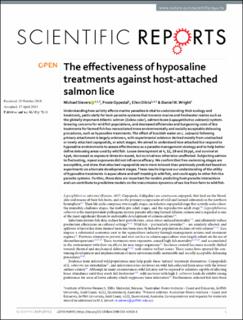| dc.description.abstract | Understanding how salinity affects marine parasites is vital to understanding their ecology and treatment, particularly for host-parasite systems that traverse marine and freshwater realms such as the globally important Atlantic salmon (Salmo salar), salmon louse (Lepeophtheirus salmonis) system. Growing concerns for wild fish populations, and decreased efficiencies and burgeoning costs of lice treatments for farmed fish has necessitated more environmentally and socially acceptable delousing procedures, such as hyposaline treatments. The effect of brackish water on L. salmonis following primary attachment is largely unknown, with experimental evidence derived mostly from unattached or newly attached copepodids, or adult stages. We aimed to understand how attached lice respond to hyposaline environments to assess effectiveness as a parasite management strategy and to help better define delousing areas used by wild fish. Louse development at 4, 12, 19 and 26 ppt, and survival at 4 ppt, decreased as exposure times increased, but survival was otherwise unaffected. Subjecting salmon to fluctuating, repeat exposures did not influence efficacy. We confirm that free-swimming stages are susceptible, and show that attached copepodids were more tolerant than previously predicted based on experiments on alternate development stages. These results improve our understanding of the utility of hyposaline treatments in aquaculture and self-treating in wild fish, and could apply to other fish-lice parasite systems. Further, these data are important for models predicting host-parasite interactions and can contribute to predictive models on the transmission dynamics of sea lice from farm to wild fish. | en_US |
